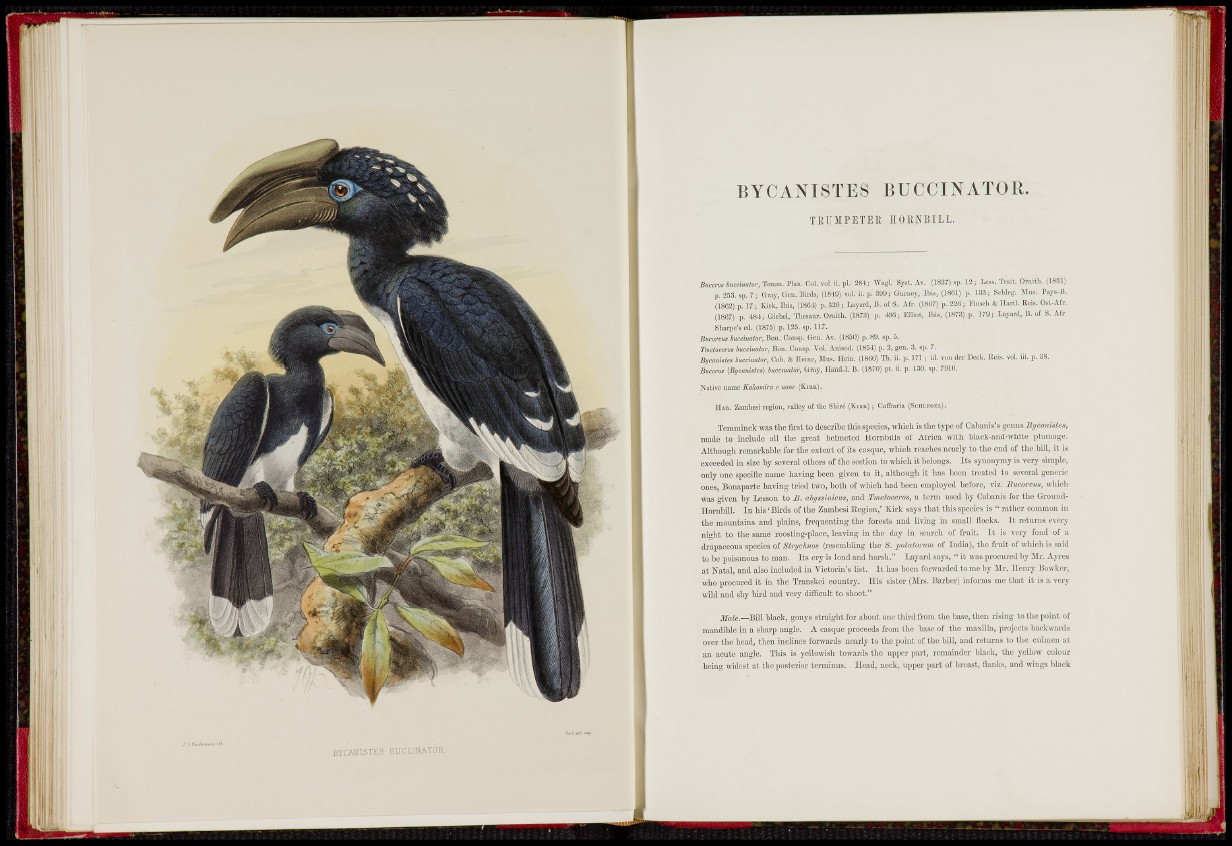
BYCANISTES BUCCINATOR.
T E U M P E T E E HOENBILL.
Buceros buccinator, Temm. Plan. Col. vol. ii. pi. 284; AVagl. Syst. Av. (1827) sp. 12; Less. Ti'ait. Ornith. (1831)
p. 253. sp. 7 ; Gray, Gcii. IHrcls, (1849) vol. ii. p. 390; Gurney, Ibis, (1861) p. 133; ScMeg. Miis. Pays-Ji.
(1862) p. 17; Kirk, Ibis, (18G4) p. 326; Layard, B. o£ S. Afr. (1867) p. 226; Piusch & llartl. Ilcis. Ost-Afr.
(1867) p. 4«4'; Giebel, Tliesaur. Ornith. (1872) p. 496; Elliot, Ibis, (1873) p. 179; Layard, B. of S. Afr
Sharpo's ed. (1875) p. 125. sp. 117.
Bucorvvs buccinator, Bon. Coiisp. Gen. Av. (1850) p. 89. sp. 5.
Tmetoccros buccinator, Boii. Consp. Vol. Aiiisod. (1854) p. 2, gen. 3. sp. 7.
Bycanistes buccinator, Cab. & Heine, Mus. Hein. (1860) Tli, ii. p. 171; id. von dcr Deck. Ecis. vol. iii. p. 38.
Buceros (Bycanittes) hiiccinator. Gray, IIand-1. B. (1870) pt. ii. p. 130. sp. 7910.
Native name Kalcamira e rwnv (Kiiik).
Hab. Zambesi region, valley of tliu Shire (Kiiik); Caffraria (SuuLiiOEi.).
Temminck was the first to desoribo this species, which is the type of Cahanis's genus BycanMes,
made to include all the great hclmetcd Ilornbills of Africa with black-and-white plumage.
Although remarkable for the extent of its casque, which reaches nearly to the end of the bill, it is
exceeded in size by several others of the section to which it belongs. Its synonymy is very simple,
only one specific name having been given to it, although it has been treated to several goD(iric
ones, Bonaparte having tried two, both of which had been employed before, viz. Bucorvue, which
was given by Lesson to B. ahyssinicus, and Tmetoceros, a term used by Cabanis for the Ground-
Eornbill. In his 'Bn-ds of the Zambesi Region,' Kirlc says that this species is " rather common in
the moimtains and plains, frequenting the forests and living in small flocks. It returns eveiy
night to the same roosting-place, leaving in the day in search of fruit. It is very fond of a
drupaceous species of Stryclmos (rcscml)ling the S. potatorum of India), the fruit of which is said
to be poisonous to man. Its cry is loud and harsh." Layard says, " it was procured by i l r . Ayres
at Natal, and also included in Victorin's list. It has been forwarded to me by Mr. Henry Bowker,
who procured it in the Transkei country. Ilis sister (Mrs. Barber) informs me that it is a very
wild and shy bird and very difficult to slioot."
Male.—Bill black, gonys straight for about one tliii-d from the base, then rising to the point of
mandible in a sharp angle. A casque proceeds from the base of the maxilla, projects baclcwards
over the head, then inclines forwards nearly to the point of the bill, and returns to the culmen at
an acute angle. This is yellowish towards the upper part, remainder black, the yellow colour
being widest at the posterior terminus, Head, neck, upper part of breast, flanks, and wings black
BYCANkSTKv^ BUCCINATOR.
.J
L l